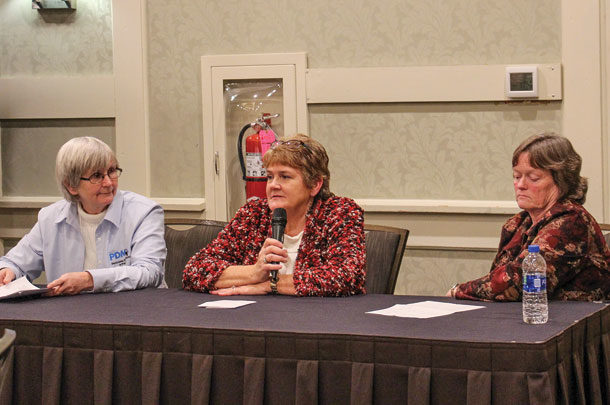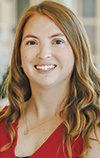Serving on boards, both in the dairy industry and beyond, allows dairy professionals to personally impact their communities and shape the future of the industry. For many dairy producers, board representation provides an avenue to expand their voices and develop mutually beneficial networking relationships.
At the 2019 Women in Dairy Conference held in Harrisburg, Pennsylvania, a panel of women shared their views on board representation and discussed their experiences serving on boards across the dairy industry.
The panel featured Christine Waddell of Townville, Pennsylvania; Lolly Lesher of Bernville, Pennsylvania and Diane Hartman of Sinking Spring, Pennsylvania.
Christine Waddell operates Apple Shamrock Dairy Farms in northwestern Pennsylvania with her husband. She manages the farm’s accounting and currently serves on the AgChoice Farm Credit Board of Directors as a member of the audit committee.
Lolly Lesher milks 250 cows with her family at Way-Har Farms and Way-Har Farm Market. She serves on the Helping Harvest Fresh Food Bank Board of Directors and previously served as the chairman of the Center for Dairy Excellence Board of Directors.
Diane Hartman operates Scattered Acres Inc. and brings her experience as a dairy producer to both the Center for Dairy Excellence and Professional Dairy Managers of Pennsylvania (PDMP) Board of Directors.
Investing time and passion
The panel agreed that the decision to join dairy industry boards started with their desire to share their passion with others. For Lesher, investing her time into organizations that align with her core values has been an important part of her journey. As a dairy producer and wholesale business owner, serving on the Helping Harvest Fresh Food Bank Board of Directors has allowed her to expand dairy’s voice in her local community while gaining insight from consumers.
“Make sure you personally align with where the board is headed or it won’t be time well invested,” Lesher shared. “Serving on a board should be mutually beneficial. If it’s mutually beneficial, I’m presenting something to the board that they can grow from. What am I getting out of it? It might be learning something I can take back to the family farm or gaining professional development.”
Waddell noted that aligning your talents and passions with the organization’s mission can also lead to a more engaged board. Based on her experience with the board of directors for AgChoice Farm Credit, full buy-in from every member has helped the board grow.
“Everyone needs to be present for full engagement from the board,” Waddell said. “It becomes very apparent when someone is just checking the clock. The boards that work well are open-minded and fully engaged.”
Building relationships
In addition to connecting with the board’s mission, the panel discussed the significance of networking and building relationships. Hartman recalled a time where she received nutritional advice from one of her fellow board members – a takeaway that was instrumental to her farm operation.
“[Serving on boards] gives me opportunities to see what else is out there. We realized we were spending way too much on our feed, so I talked at board meetings and learned who people were using as nutritionists,” Hartman shared. “We changed nutritionists and realized we could save $200,000 a year on just one of our milking facilities. That’s just one example of what I learned in a board meeting.”
Lesher, while serving as chairman of the Center for Dairy Excellence Board of Directors, was responsible for engaging with legislators and consumers to request funding for Foundation programs.
“Serving on the board opens up other doors. Maybe I’ll meet people who invite me to speak at functions or attend meetings in my local area,” Lesher said. “You can tell your story in so many ways and reach so many people.”
The panelists agreed that making decisions with board members who have diverse experiences and backgrounds has helped them become open to new ideas.
“Even if it’s just working with a diverse group of people, you bring back so many little things that can add up to big things,” Waddell shared.
Embracing responsibility
While the panelists described the positive experiences that can result from board representation, they also reminded the audience of their commitments and responsibilities. During Waddell’s time on the AgChoice Farm Credit Board of Directors, she attends seven meetings a year and spends a total of 25 days a year away from the farm in meetings and trainings.
“We’re setting policies for the whole organization through the decisions we make. There’s a lot of responsibility, so you need to keep that in mind,” Waddell said. “Understand the time commitments. You’re bringing something to the table, and you’re getting something back. There’s always a give and take. It’s a win-win all the way around.”
Hartman emphasized the importance of closely considering your time and schedule before serving on a board. She spends approximately 80 hours a year serving on both boards, which includes in-person meetings, conference calls, email and travel.
“You have to look at your time and scheduling. Be sure you can commit the time before going onto the board, and make sure you know what the board stands for,” Hartman said.
Beyond the time commitment, the panelists discussed the various skillsets they need as board members, including financial understanding. They also agreed that being prepared and reading material ahead of meetings is necessary to having a fully engaged and responsible board.
“When we plan for the next year, our leadership asks what type of trainings we want. There’s a very definite need to have some sort of financial understanding,” Waddell shared. “If you don’t know, ask. You are responsible for the decisions and policies you create and the motions you pass.”
Shaping the future of dairy
The panelists each shared their personal reasons for serving on boards, but they all agreed that shaping the future of dairy is what makes their experiences so rewarding. For Hartman, serving on boards has given her the chance to represent her family and leave a lasting imprint on the industry.
“When I was thinking about why I wanted to go on the board, there were so many influences. My parents and in-laws were great influences – they didn’t stay on the farm. They went to meetings at night,” Hartman shared. “So, if I don’t go and represent my family, who’s going to represent them? If we don’t keep the dairy industry going, who’s going to?”
Lesher added that shaping the future of the industry might start with a simple conversation with a member of the community. She said her board representation has given her the platform to share the positive story of dairy with individuals who might not understand the industry.
“I think getting involved in the community is more important than getting involved in dairy. A lot of us in dairy already understand it. It’s our neighbors who don’t get it,” Lesher said. “Every time I go to my Food Bank meeting, I always have a really positive dairy story to share. I think being involved in the community is an important part of sharing that story one-on-one. That’s how we’re going to win them over.”






